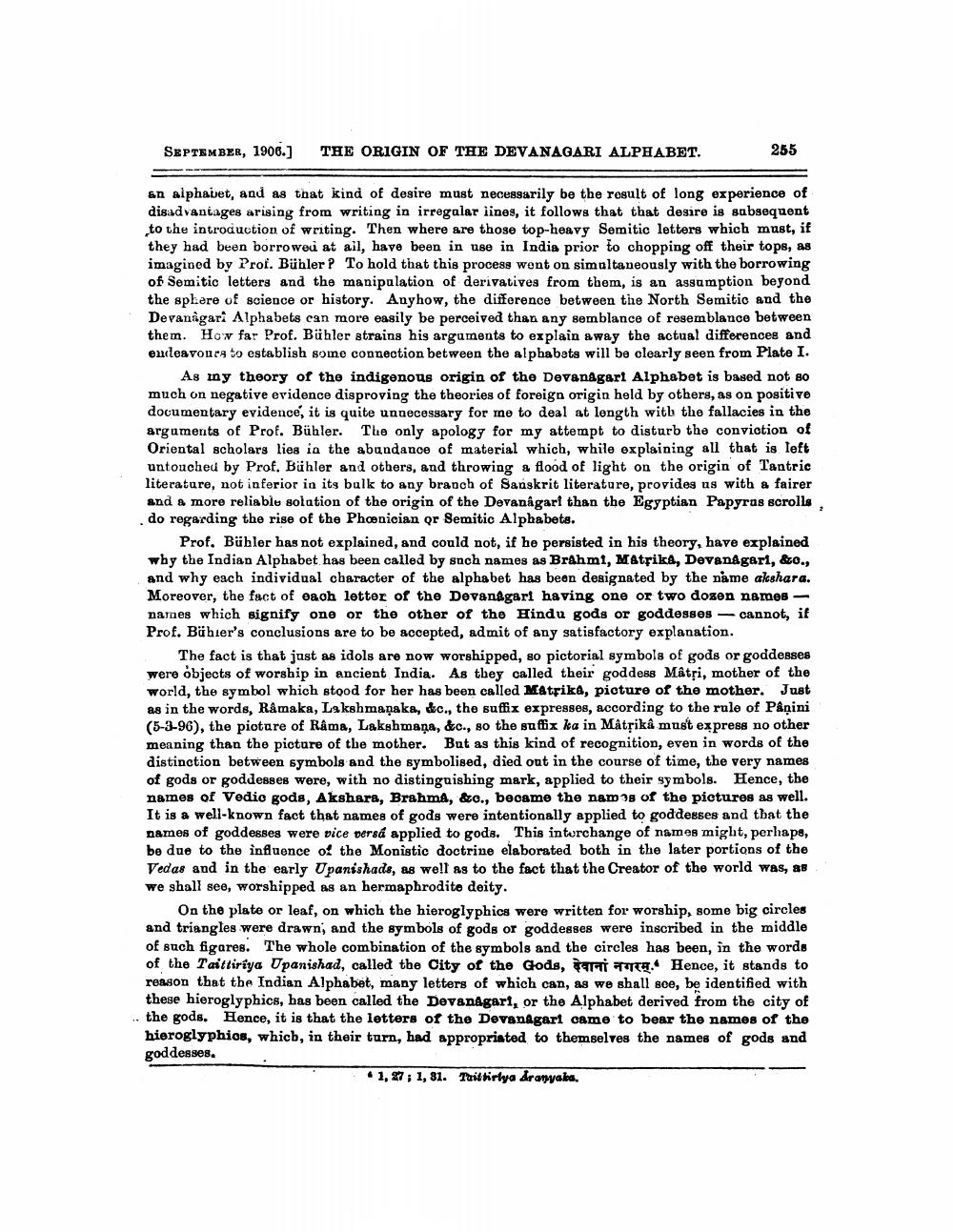________________
SEPTEMBER, 1906.)
THE ORIGIN OF THE DEVANAGARI ALPHABET.
255
en alphabet, and as that kind of desire must necessarily be the result of long experience of disadvantages arising from writing in irregalar lines, it follows that that desire is subsequent to the introduction of writing. Then where are those top-heavy Semitic letters which must, if they had been borrowed at ail, have been in use in India prior to chopping off their tops, as imagined by Prof. Bühler? To hold that this process went on simultaneously with the borrowing of Semitic letters and the manipulation of derivatives from them, is an assumption beyond the sphere of science or history. Anyhow, the difference between the North Semitic and the Devanagari Alphabets can more easily be perceived than any semblance of resemblance between them. How far Prof. Bühler strains his arguments to explain away the actual differences and endeavours to establish some connection between the alphabets will be clearly seen from Plate I.
As iny theory of the indigenous origin of the Devanagart Alphabet is based not 80 much on negative evidence disproving the theories of foreign origin held by others, as on positive documentary evidence, it is quite unnecessary for me to deal at length with the fallacies in the arguments of Prof. Bühler. The only apology for my attempt to disturb the conviction of Oriental scholars lies in the abundance of material which, while explaining all that is left untouched by Prof. Bühler and others, and throwing a flood of light on the origin of Tantric literature, not inferior in its balk to any branch of Sanskrit literature, provides us with a fairer and a more reliable solation of the origin of the Devanagart than the Egyptian Papyras scrolls do regarding the rise of the Phoenician or Semitic Alphabete.
Prof, Bühler has not explained, and could not, if he persisted in his theory, have explained why the Indian Alphabet has been called by such names as Brahmi, Matrike, Devanagari, &o., and why each individual character of the alphabet has been designated by the name akshara. Moreover, the fact of each letter of the Devanagart having one or two dozen names - names which signify one or the other of the Hindu gods or goddesses cannot, if Prof. Bühler's conclusions are to be accepted, admit of any satisfactory explanation.
The fact is that just as idols are now worshipped, so pictorial symbols of gods or goddesses were objects of worship in ancient India. As they called their goddess Mâtsi, mother of the world, the symbol which stood for her has been called Matrika, picture of the mother. Just as in the words, Râmaka, Lakshmanaka, &c., the suffix expresses, according to the rule of Påņini (5-3-96), the pioture of Râma, Lakshmana, &c., so the suffix ka in Mâtsikâ must express no other meaning than the picture of the mother. But as this kind of recognition, even in words of the distinction between symbols and the symbolised, died out in the course of time, the very names of gods or goddesses were, with no distinguishing mark, applied to their symbols. Hence, the names of Vedic gods, Akshara, Brahma, &c., became the nam 8 of the pictures as well. It is a well-known fact that names of gods were intentionally applied to goddesses and that the names of goddesses were vice persá applied to gods. This interchange of names might, perhaps, be due to the influence of the Monistic doctrine elaborated both in the later portions of the Vedas and in the early Upanishads, as well as to the fact that the Creator of the world was, 88 we shall see, worshipped as an hermaphrodite deity.
On the plate or leaf, on which the hieroglyphics were written for worship, some big circles and triangles were drawn, and the symbols of gods or goddesses were inscribed in the middle of such figares. The whole combination of the symbols and the circles has been in the words of the Taittiriya Upanishad, called the City of the Gods, TT TTTA. Hence, it stands to reason that the Indian Alphabet, many letters of which can, as we shall soe, be identified with these hieroglyphics, has been called the Devanagari, or the Alphabet derived from the city of the gods. Hence, it is that the letters of the Devanagart came to bear the names of the hieroglyphios, whicb, in their turn, had appropriated to themselves the names of gods and goddesses.
. 1,27; 1, 81. Taittirlya Aranyala.




